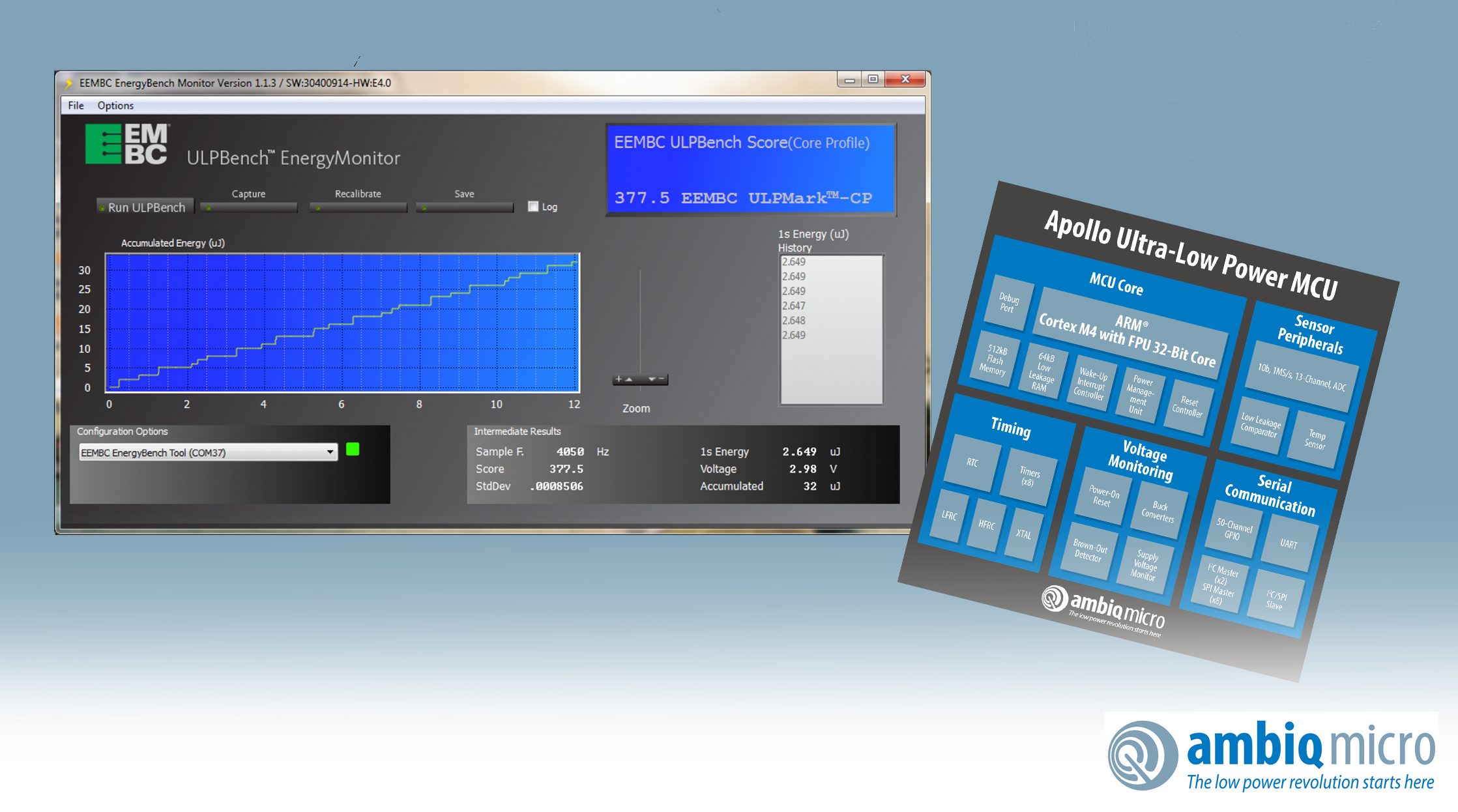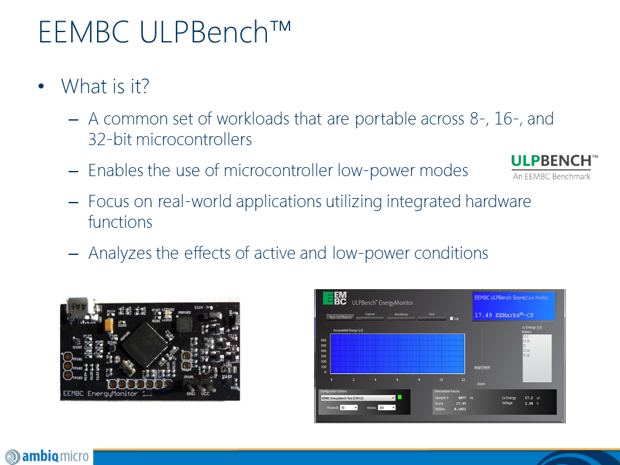
by Lidia Paulinska | Nov 23, 2015
At the ARM TechCon in Santa Clara, Texas based Ambiq Micro announced the capabilities of their latest MCU for the IoT market. In an overview dinner with CEO Mike Noonen, VP of Marketing and Strategy Mike Salas, CTO Scott Hanson and VP Sales Vince Murdica they discussed the release of their new 32 bit MCU for the wearables and IoT market that is based on the ARM Cortex Core. The design uses the Ambiq Micro Sub-threshold technology to produce a processor that can be benchmarked at the lowest power in its class.
The product has recently moved to volume production, and is being used in a currently available sleep monitor and fitness monitor. To support the design, which is an ARM M4 core with FLASH memory and FPU, is a software development kit, a Free RTOS and a full development board. Wireless development products, supporting a Bluetooth Low Energy connection, from their partner Dialog Semiconductor, were on display at the show. All of these development products are currently available.
The system can be operated at voltages down to 2 volts which allows the system to have extended operation between charges, bringing new lifestyle applications to the IoT and wearables marketplace.


by Lidia Paulinska | Aug 9, 2015
July 2015 – At the IMEC Technology Forum prior to the start of Semicon West 2015, President Luc Van Den Hove started his presentation with bringing the times when the servants were on service for rich people. They were “invisible” eyes and hands that were ready for any request. Today, the role of technology is to take that place. Just like the servants years ago nowadays technology has to learn how to become smarter and serve the needs of people better. The only difference he said, is that instead of creating a comfortable living for just a few people, technology can make many people on our planet happy and comfortable.
One of the groups that really see the changes in their standard of living by using technology in the form of electronics devices, are senior citizens. The market for wearables is going to reach $80B USD by 2020. A heavy focus of the market will be on that segment. It is important that the use of wearables fade into our life and be se seamlessly integrated, intuitive and minimally simple. IMEC’s advanced wearable solutions laid the foundations for the creation of intuitive environments. They are bridging the technology gaps in the platform of sensors by evolving them from being just smart to being intuitive. In concluding on the sensors, he stated that in order to serve properly, the sensors have to be: invisible, low cost, ultra-low power, manage multiple parameters and be accurate in normal operation. As an example Mr Van Den Hove described the use of wearables that have utilized IMEC technology as such: a textile-integrated health patch, an EEG platform that provides quality and comfort for users, the Samsung Simband with IMEC Sensing Technology and the Embracelet taking a role of a personal assistant for the elderly.
The presentation continued to show that the logical extension to the use of those technology will be heading in the direction of context-aware sensing & smart personalized algorithms. These will require seamless heterogeneous wireless connectivity that includes cloud communication that will be driving the evolution of higher data rates with short latency. This will create an infrastructure-centric communication environment that is supported by “zero” maintenance along with both data and connection safety and security. To help support this trend, IMEC has developed technology for software reconfigurable radios for 4G and 5G cellular use as well as radios for zigbee and smart metering WiFi sensors. The person-centric communication environment is evolving towards lower power data transfers that the resulting big data & analytics. As a side light at the presentation they showed advancement in the area of data and low power communication was the IMEC developed world’s lowest power BLE solution.
As we know happy people worry less. The presenter observed that technology does not solve some of the societal stress factors such as money, work or economy. Technology however, is definitely helpful to address and solve some of concerns related to health problems. Advance technology development for the investigation of cancer issues range from electronics for the separation and identification of cancer cells to combating metastatic cancer. IMEC is bridging the technology gaps required by the creation of high-throughput high-content cell screening. As an example they showed a solution developed with Nano-electronics that sorts 20 million cells/sec and classifies them in real time at the rate of 2000 images/sec. Transportation is another are that technology has put its footprint on, and is being used to address a holistic approach to the field. The Holy Grail, of course are autonomous cars that can operation in the cross paths of safety, comfort and efficiency. But autonomous driving would not be gaining momentum nor achieve ubiquitous use, without low-cost mass-produced radars. Technology is heading towards the production of high performance radars in a single CMOS chip. IMEC presented the world’s first high-resolution 79GHz CMOS radar module. Another step towards bridging the required technology gaps is the creation of new user interfaces. These include a 3D vision skin and the use of acoustic holograms. Searching into nature, researchers chose to mimic the view seen in the eye of a fly and combine it with echo-location. This has created a vision and ultrasound system integrated in flex 3D vision skin. The skin is composed of arrays of thin-film photodetectors & piezo-electric devices & with distributed control electronic.
Next part of the presentation of Mr Van Den Hove focused on sources and technology for renewable energy. Solar photovoltaic PV conversion outputs for silicon solar cells are currently efficient to rates below an average of 20%. For energy storage, solid-state Li-Ion batteries are required to be compact, safe, high power & have a high energy density. New technology is working on 3D solid-state batteries where the challenges are to create them to be fast, reliable and safe charging. The future that will use these technologies is being driven by smart cities heading towards the design and building of net zero-energy buildings. To help address this, IMEC has developed a solar cell that has a World-record efficiency of 22.5% with an N-pert silicon solar cell. Final food production was addressed as an area that will require a activity and high attention. IMEC has created solutions including compact hyperspectral imaging electronics and cameras that can be attached to the drones. These imaging solutions are being used in inspection of the food on the field to help increase yield from the crops.


